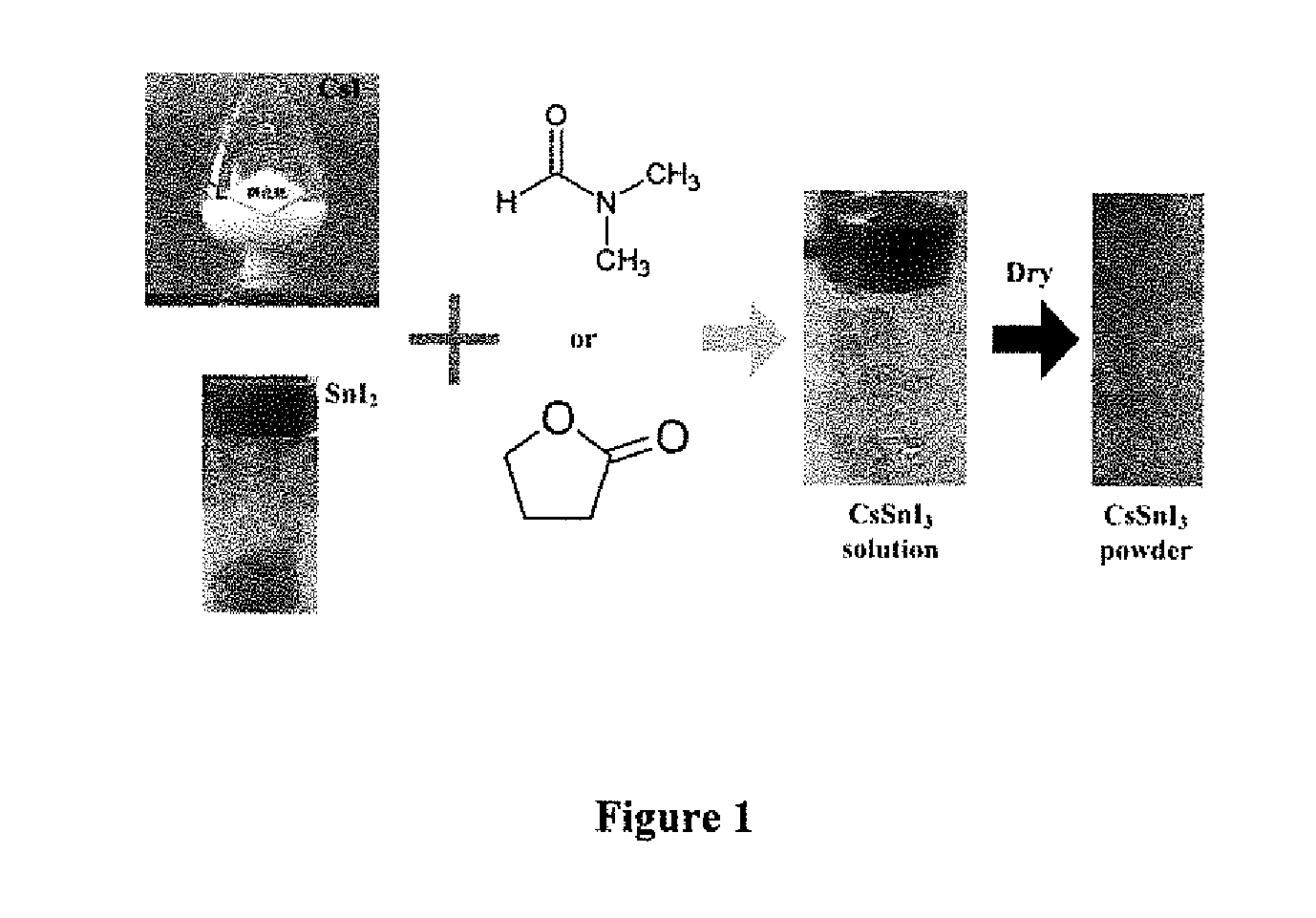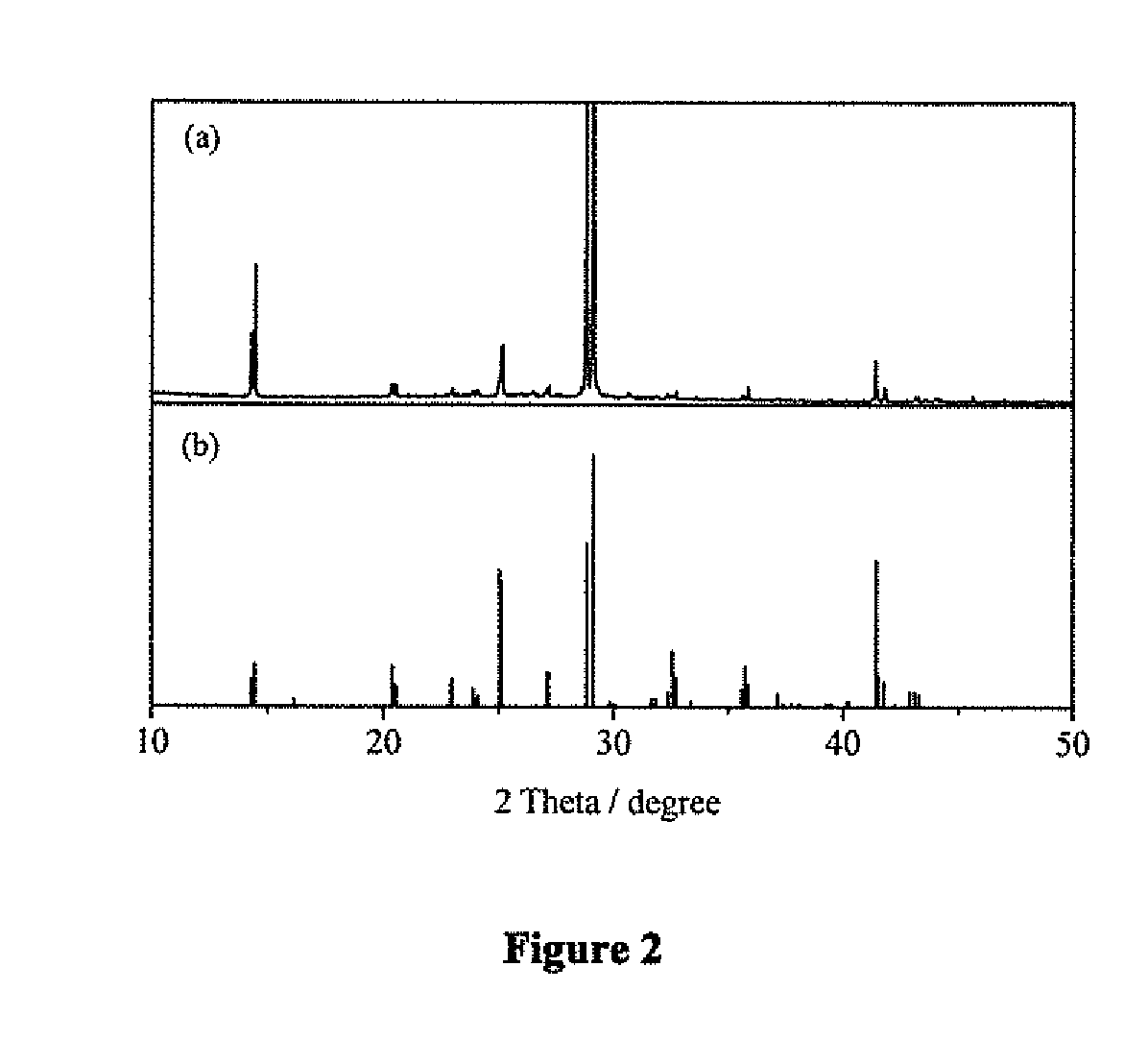SYNTHESIS OF CsSnI3 BY A SOLUTION BASED METHOD
a technology of synthesis and solution, applied in the field of photovoltaic device material formation, can solve the problems of high production cos
- Summary
- Abstract
- Description
- Claims
- Application Information
AI Technical Summary
Benefits of technology
Problems solved by technology
Method used
Image
Examples
working examples
Example 1
Preparation of CsI Solution
[0073]Initially, 0.13 gram of CsI (99.999% purity) powder was added to 10 mL GBL. The CsI powder was fully dissolved in GBL. The CsI solution was stirred for 30 minutes.
[0074]CsI solution was colorless and stable in glove box.
[0075]It would be apparent to one skilled in the art that CsI solutions could be made using any solvents in addition to those used in the examples. Examples of solvents that can be used include but are not limited to N,N-dimethylformamide (DMF), γ-butyrolactone (GBL) and mixtures thereof.
[0076]The concentration range of the CsI solution was from about 25 mmol / L to 500 mmol / L.
example 2
Preparation of SnI2 Solution
[0077]Initially, 0.186 gram of SnI2 (99% purity) powder was added to 10 mL GBL. The SnI2 powder was fully dissolved in GBL. The SnI2 solution was stirred for 30 minutes.
[0078]SnI2 solution was yellow and stable in glove box.
[0079]It would be apparent to one skilled in the art that SnI2 solutions could be made using any solvents in addition to those used in the examples. Examples of solvents that can be used include but are not limited to, DMF, GBL or mixtures thereof.
[0080]The concentration range of the SnI2 solution was from about 25 mmol / L to 500 mmol / L.
example 3
Synthesis of CsSnI3
[0081]A given amount of the prepared CsI solution was transferred to a reaction vial first. SnI2 solution or powder was then slowly added into the vial. The concentrations range of CsI and SnI2 were both in a range of 25 mmol / L to 500 mmol / L, and their molar ratio was 1:1.
[0082]The mixed solution was stirred for 12 to 24 hours, and a uniform and transparent yellow CsSnI3 solution was formed.
[0083]The homogeneous CsSnI3 solution was dried until the solvent was all evaporated. The heating temperature ranged from about 100° C. to 200° C. Then the pure black CsSnI3 powder with metallic luster was obtained as shown in FIG. 1. The chemical reaction for the mixed solution could be described as the following:
CsI+SnI2→CsSnI3
The reaction was verified by identifying the end products of CsSnI3 using the X-ray diffraction (XRD) data.
[0084]FIG. 2 (a) shows the XRD data profile taken from CsSnI3 (concentrations of CsI and SnI2 were both 50 mmol / L).
[0085]FIG. 2 (b) showed the s...
PUM
| Property | Measurement | Unit |
|---|---|---|
| temperature | aaaaa | aaaaa |
| band gaps | aaaaa | aaaaa |
| absolute pressure | aaaaa | aaaaa |
Abstract
Description
Claims
Application Information
 Login to View More
Login to View More - R&D
- Intellectual Property
- Life Sciences
- Materials
- Tech Scout
- Unparalleled Data Quality
- Higher Quality Content
- 60% Fewer Hallucinations
Browse by: Latest US Patents, China's latest patents, Technical Efficacy Thesaurus, Application Domain, Technology Topic, Popular Technical Reports.
© 2025 PatSnap. All rights reserved.Legal|Privacy policy|Modern Slavery Act Transparency Statement|Sitemap|About US| Contact US: help@patsnap.com


